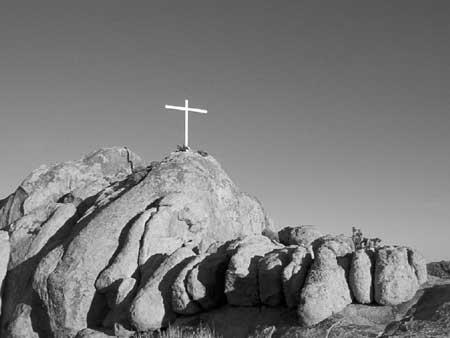Brace yourself, I'm about to delve into one of those public conversation taboos. You know, you don't talk sex, politics, or religion in public.
But at times I find the debates spurred by symbols fascinating. And, of course, religious symbols seem to spur the most debates. The one I want to focus on involves Mojave National Preserve, where a federal judge has ruled that a cross can no longer stand atop Sunrise Rock.
The cross, a simple unadorned one, dates to 1934, when a wooden one was raised in honor of Americans who died during World War I. It later was replaced by a more enduring metal cross. As you look at it, it seems like a simple tribute. And yet in 2001 Frank Buono, a former National Park Service assistant superintendent at the preserve, filed a lawsuit, supported by the American Civil Liberties Union, to have the cross removed.
Court papers from an earlier stage in the case noted that Buono was "deeply offended by the display of a Latin Cross on government-owned property," reads a story from the San Bernardino Sun.
Look at the picture. Are you "deeply offended" by the cross?
In her ruling, Judge M. Margaret McKeown held that the cross's location within the national preserve is an unconstitutional federal endorsement of Christianity.
This case has me wondering if there's a point when a symbol, religious or otherwise, becomes more a part of our country's history, of our social fabric, our culture, than it does a symbol of what it was initially viewed as? Beyond that, will this ruling lead the Park Service to remove any and all symbols or structures located within its properties that can be construed as religious? Should it prohibit any and all religious services?
Why did the judge in this case rule against the federal government, and yet back in 2000 a court dismissed a lawsuit claiming the federal government was endorsing a Native American religion by restricting access to Rainbow Bridge at Rainbow Bridge National Monument?
Of course, in the Rainbow Bridge case the court held that the couple that brought the lawsuit had suffered no personal injury and so had no standing. But what personal injury did Mr. Buono suffer in the Mojave Preserve matter?
Look elsewhere in the park system. The Park Service earlier this year designated a synagogue designed by Frank Lloyd Wright as a National Historic Landmark. Could someone argue that means the government endorses Judaism?
At Devil's Tower National Monument in Wyoming conflicts arise when Native Americans want to hold ceremonies at the tower and ask that climbing be restricted.
And then there's the Christian Ministry In the National Parks, which holds non-denominational services every Sunday during the summer in more than 35 national parks. By permitting these services, does the Park Service tacitly endorse religion in general?
As these cases reflect, there are no quick, clearcut answers to these questions. Judges seemingly have different standards when weighing the merits of the cases before them. Across the country, different segments of our population hold different values.
Where do you draw the line? How do you decide what should be allowed, and what should not? Should the parks be so aseptic of some segments of America's culture? How do you decide which symbols are offensive and which are not? If the cross in question were taken down and replaced by a monument, would that be OK?
Religion long has played a role in this country's evolution. The Founding Fathers were pious men, the explorers who opened up the West often talked of the majesty "He" created. Even John Muir referred to God in his writings about nature:
In God's wildness lies the hope of the world - the great fresh unblighted, unredeemed wilderness. The galling harness of civilization drops off, and wounds heal ere we are aware.
- John of the Mountains, (1938) page 317.
I've long viewed myself as a secularist, and certainly don't want to see crosses and other symbols, religious or otherwise, sprouting on hills and mountaintops across the park system. And yet, are there times when you wonder whether we go too far in striving to be politically correct?
Frankly, perhaps it would have been best if the judge in the Mojave case simply ruled that the cross did not belong in the preserve, regardless of whether it had any religious connotations.




Add comment